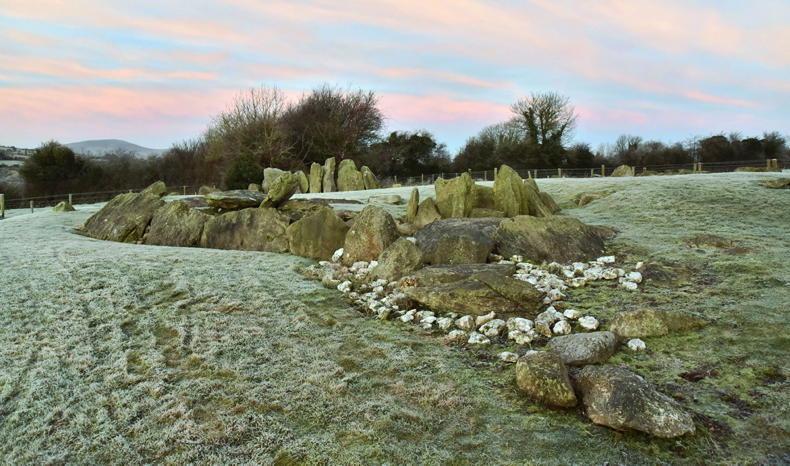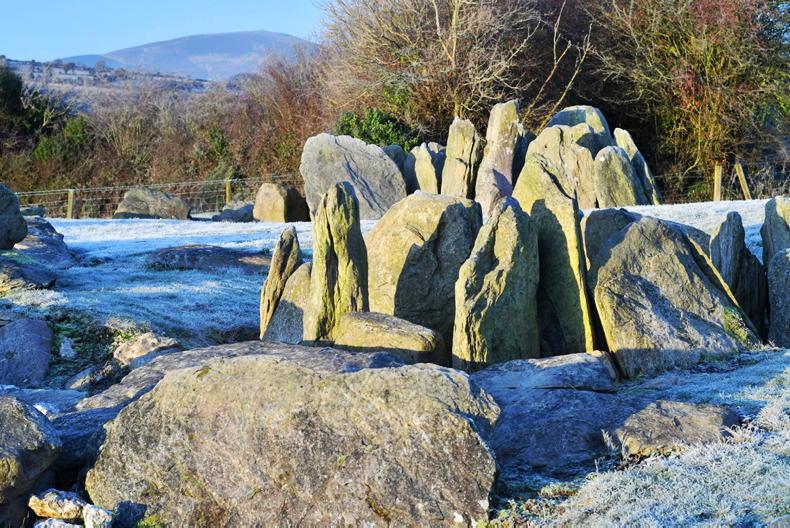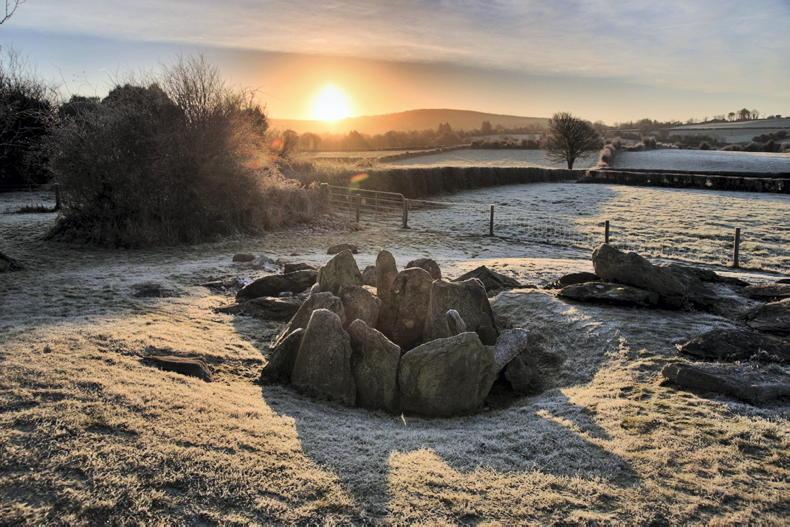The Neolithic period saw the arrival of the first farmers to Ireland around 4000BC. They brought with them better farming systems and domesticated animals, which in time pushed out the nomadic hunters. Tools were an important introduction also, from stone axes to querns for grinding corn. Farming was mixed, forests were cleared and farmland such as the Céide fields in Co Mayo were laid out.
The people of this period also built the megalithic tombs, the most familiar of these to us is most likely Newgrange in Co Meath.
Tombs like Newgrange are often orientated on important phases of the suns yearly cycle such as the Winter Solstice. This event – December 21 each year – is celebrated as it marks the end of the short days and with the lengthening of the days, brings the promise of new growth. It is no surprise that this day was celebrated by these early farmers.
Although, perhaps most associated with Meath, there are others, preserved by the combined effort of the OPW (Office of Public Works) and local communities.

Showing white quartz in front of eastern chamber and outer ring of Kerbstones.
One such example is Knockroe passage tomb or as it is known locally “The Caiseal” in Co Kilkenny. This passage tomb stands unique in that it is the only site in Ireland, and perhaps in Europe, which has both an east -facing and a west-facing tomb – a double megalithic tomb. The significance of this? It can be illuminated by both the rising sun which happens at approximately 8.40am as well as the setting sun at approximately 3.40pm on the day of the winter solstice.
Knockroe Neolithic passage tomb has only been excavated since 1990. It has about 30 decorated stones and, like Newgrange, the face of the cairn flanking the eastern tomb was decorated with a frieze of quartz which reflects the sun. The roof-box in the western tomb allows the rays of the sun to pass along the upward-sloping passage on 21 December, when it illuminates a tall red-sandstone portal.
In previous years, 300 people attended the morning event and 500 in the evening, coming from across the country. The celebration of this phenomenon has been organised by a small committee of local people in the Linguan Valley for several years – the Caiseal Conservation Committee.
Tullahought man Richard Walsh is the treasurer of the group and he tells us what is happening now in the COVID-19 year of 2020.
“This year the OPW has given us permission to livestream both the morning sunrise and the evening sunset. They purchased the site from the farmer that owned it back when the excavations began, so we need their permission.”

Eastern chamber (sunrise) in foreground with western chamber (sunset) in background and Slievenamon mountain in distance.
However, Knockroe is only one of the many archaeological assets that the Linguan Valley boasts. The Killamery High Cross, which we covered early on in our Local Treasures series is another.
The Lingaun River Valley forms part of the Kilkenny and Tipperary border with its source in the foothills of Slievenamon.
Richard and the committee have been working hard to highlight the wealth of ancient and historic scattered along the path of the valley including, Carrigmoclear Hill, the Ahenny and Kilkieran High Crosses, Carrigadoon Hill Fort and the Slate Quarries.
“We also have a wonderful website launched this year on the Linguan Valley. With the support of Kilkenny leader, we have also erected a number of fingerpost signs which direct visitors along the path, from monument to monument.
“We only have these in Kilkenny at the moment but Tipperary leader has come on board now too and we hope to have the signs up on the Tipperary side in 2021. We would welcome any support also from the public.”
The committee are asking that visitors, who are welcome to visit the site within restrictions, do not travel this year on the day of the Solstice.
“We are concerned of crowds gathering,” Richard tells us, but he encourages everyone to tune in for the live stream on their Facebook page on 21 December. Do as we were instructed and “Google ‘Knockroe’”.
Read more
The Hogans: brothers in farming, freedom, religion and GAA history
The origins of modern farming being uncovered in Meath
The Neolithic period saw the arrival of the first farmers to Ireland around 4000BC. They brought with them better farming systems and domesticated animals, which in time pushed out the nomadic hunters. Tools were an important introduction also, from stone axes to querns for grinding corn. Farming was mixed, forests were cleared and farmland such as the Céide fields in Co Mayo were laid out.
The people of this period also built the megalithic tombs, the most familiar of these to us is most likely Newgrange in Co Meath.
Tombs like Newgrange are often orientated on important phases of the suns yearly cycle such as the Winter Solstice. This event – December 21 each year – is celebrated as it marks the end of the short days and with the lengthening of the days, brings the promise of new growth. It is no surprise that this day was celebrated by these early farmers.
Although, perhaps most associated with Meath, there are others, preserved by the combined effort of the OPW (Office of Public Works) and local communities.

Showing white quartz in front of eastern chamber and outer ring of Kerbstones.
One such example is Knockroe passage tomb or as it is known locally “The Caiseal” in Co Kilkenny. This passage tomb stands unique in that it is the only site in Ireland, and perhaps in Europe, which has both an east -facing and a west-facing tomb – a double megalithic tomb. The significance of this? It can be illuminated by both the rising sun which happens at approximately 8.40am as well as the setting sun at approximately 3.40pm on the day of the winter solstice.
Knockroe Neolithic passage tomb has only been excavated since 1990. It has about 30 decorated stones and, like Newgrange, the face of the cairn flanking the eastern tomb was decorated with a frieze of quartz which reflects the sun. The roof-box in the western tomb allows the rays of the sun to pass along the upward-sloping passage on 21 December, when it illuminates a tall red-sandstone portal.
In previous years, 300 people attended the morning event and 500 in the evening, coming from across the country. The celebration of this phenomenon has been organised by a small committee of local people in the Linguan Valley for several years – the Caiseal Conservation Committee.
Tullahought man Richard Walsh is the treasurer of the group and he tells us what is happening now in the COVID-19 year of 2020.
“This year the OPW has given us permission to livestream both the morning sunrise and the evening sunset. They purchased the site from the farmer that owned it back when the excavations began, so we need their permission.”

Eastern chamber (sunrise) in foreground with western chamber (sunset) in background and Slievenamon mountain in distance.
However, Knockroe is only one of the many archaeological assets that the Linguan Valley boasts. The Killamery High Cross, which we covered early on in our Local Treasures series is another.
The Lingaun River Valley forms part of the Kilkenny and Tipperary border with its source in the foothills of Slievenamon.
Richard and the committee have been working hard to highlight the wealth of ancient and historic scattered along the path of the valley including, Carrigmoclear Hill, the Ahenny and Kilkieran High Crosses, Carrigadoon Hill Fort and the Slate Quarries.
“We also have a wonderful website launched this year on the Linguan Valley. With the support of Kilkenny leader, we have also erected a number of fingerpost signs which direct visitors along the path, from monument to monument.
“We only have these in Kilkenny at the moment but Tipperary leader has come on board now too and we hope to have the signs up on the Tipperary side in 2021. We would welcome any support also from the public.”
The committee are asking that visitors, who are welcome to visit the site within restrictions, do not travel this year on the day of the Solstice.
“We are concerned of crowds gathering,” Richard tells us, but he encourages everyone to tune in for the live stream on their Facebook page on 21 December. Do as we were instructed and “Google ‘Knockroe’”.
Read more
The Hogans: brothers in farming, freedom, religion and GAA history
The origins of modern farming being uncovered in Meath








 This is a subscriber-only article
This is a subscriber-only article










SHARING OPTIONS: